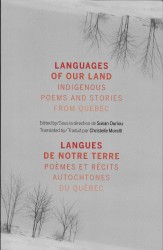Article Origin
Volume
Issue
Year
Languages of Our Land is a compelling collection of works by 12 emerging and established Indigenous writers living in Quebec, published by Banff Centre Press.
The original work is in French, which is included side-by-side with the English translation. For English only readers, the English translation is rich and captivating.
And for lucky readers of French, one can only imagine how much richer and more captivating both the prose and the poetry – especially the poetry, with the special attention that must be paid to rhythm and flow– must be.
And what if the stories could have been related in the true first languages of the authors – Wendat, Innu-aimun, Cree or Algonquin? The writing would have been even more beautiful. However, although the writers did not use their mother tongues, it is evident that the writing is influenced by the lived culture and the original language.
The writers have all been touched by the Indian residential school experience. Indeed, a couple of the poets use the word “genocide” to talk about what happened to their families, their communities, their way of life.
“Cultural genocide” was the phrase spoken by Truth and Reconciliation Commission Chair Murray Sinclair to sum up the federal government’s policy of Indian residential schools.
In “Dust of our Blood,” poet Jean Sioui writes, “My father … /One day you were the trapper/the next day you were the trapped/My father …/One day you were the hunter/the next day you were the hunted.” It is easy to feel the loss of a way of life and of culture in those few simple lines. The work of Sioui, who is Wendat from the Bear Clan, is the first in the collection and sets the tone for what is to come.
In “Lost Origin,” Manon Nolin’s despair is clear in her words: “I turned away from my origins/I lost my heart of a child/I don’t know who I am/Am I Innu?/Am I other? I am rootless.”
The way of life, of what it has become, is captured honestly in the thoughts of an old woman: “Poor Marie trying to get away from her man when the bottle turned him mean.” Simple, straightforward, and bare is the work provided by Carole Labarre in the short story, “Pishimuss.”
These poignant words capture the struggle of a people who have lost seven generations to Indian residential schools. With no culture, no language, no spiritual practises, where does the strength and direction come from to move beyond hurt and self-destructive coping techniques?
Not all the poems and short stories are about loss.
“Though the shadows of residential schools/hovers still over our communities/I know today’s youth will find there/a way to free themselves,” writes Real Junior Leblanc in the poem “Uprooted Childhood.”
And in “Day by Day,” Melina Vassiliou writes about hope: “my son’s pure gaze/his winning smile/my son’s pure gaze/my winning smile/day by day.”
In the greys and blacks of loss, the writers also share the bright colours of hope.
Writes Virginia Pesemapeo Bordeleau in the poem “Women’s Declaration of Peace,” the final selection of the anthology, “Peace is an answer/to all the wounds inflicted/on our dignity,/day after day./Peace is the condition of our healing.”
Languages of Our Land was written at the Banff Centre in Alberta. Says editor Susan Ourious in her introduction, “In the majestic setting of the Rockies, the chosen Canada Council writers were given an opportunity to reunite with the land, the river, the forests and the sky.” That reunion has created a stirring collection of prose and poetry.
- 2103 views

